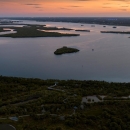Laws and Regulations
Salt Plains National Wildlife Refuge is part of the National Wildlife Refuge System. Refuges are places where wildlife comes first. All activities allowed on refuges must be evaluated to make sure it will not conflict with the reason the refuge was founded.
General Rules and Regulations:
- Open daily from sunrise to sunset. No entrance fees or passes required.
- Overnight parking, camping, and fires are prohibited.
- Stay on designated trails and public roads.
- Littering is prohibited.
- Drones are prohibited in all areas of the refuge.
- Disturbing or collecting plants and animals is prohibited.
- People possessing, transporting, or carrying firearms must comply with state and local laws. Firearms are prohibited in all buildings.
- Pets are welcome but must be on leash.
- Some commercial, recreational, and research activities are allowed only with a special use permit and are subject to specific conditions. For more information, visit the special use permits section below.
- ATV's and UTV's must stay on designated refuge roads and must comply with all state and local motor vehicle laws.
More information can be found at the 50 Code of Federal Regulations - Subchapter C. The refuge has additional hunting and fishing regulations [50 CFR, §32.55(e)]
Special Use Permits (SUP)
Some commercial, recreational, and research activities are allowed only with a special use permit and are subject to specific conditions. Applying for a permit is free, and takes at least one week to process.
For more information email Melissa Robell at melissa_robell@fws.gov or call (580) 626-4794.
Required for:
- General Activity - one-time events, educational activities, special access in a closed area (ex: 25 feet past the closed area signs on the salt flats for photography and filming), etc.
- Research and Monitoring - research and monitoring activities by students, universities, or other non-FWS organizations
- Commercial - guiding, agriculture, and trapping
For all permits:
- Drones use is prohibited.
- No litter allowed (ex: smoke bombs, confetti).
- Permittee must carry a signed copy of their approved permit while on refuge property.
- Artificial light sources must be preapproved.
Process and applications:
- Select which application depending on the proposed activity. For a salt flats special access permit use a general activities application. (General, Research and Monitoring andCommercial).
- Fill out the application as completely as possible with your contact information, specific date, time and refuge location. Provide thorough descriptions of activities, and leave as few empty fields to prevent delays in the review process. Email completed application to Melissa Robell at melissa_robell@fws.gov.
- Permits take at least one week to process. Permits are reviewed by the Refuge Manager and Biologist.
- If your permit is approved you must sign, review the special conditions, and return it to the refuge official.
Photography and filming:
The Expanding Public Lands Outdoor Recreation Experiences Act (EXPLORE Act), designed to improve outdoor recreation access and programming on federal lands and waters, including filming and still photography activities, was enacted on January 4, 2025 (Public Law 118-234).
Follow this guide to see if you need to apply for a permit:
- How many people will be involved?
- More than eight. You must apply for a general activities special use permit.
- Eight or fewer. Move on to number 2.
- Permit is not required if:
- Does not impede or intrude the experience of other visitors.
- Except as otherwise authorized, does not disturb or negatively impact a natural or cultural resource, and an environmental or scenic value.
- The person conducts this activity at a location in which the public is allowed. For example, a refuge trail.
- We do offer a special access salt flats permit for photography and filming. This permit if approved will allow you to go 25 feet past the closed area signs for a wide open view without other people in your picture. If you want this permit, you must apply for a general activities special use permit.
- Does not require exclusive use.
- Does not conduct this activity in a localized area that receives a very high volume of visitation.
- Does not use a set or staging equipment, subject to the limitation that handheld equipment (such as a tripod, monopod, and handheld lighting equipment) shall not be considered staging equipment.
- The person complies with and adheres to visitor use policies, practices, and regulations for the refuge. Ex: occurs during refuge open hours sunrise to sunset, pets on leash, and no drones.
- Is not likely to result in additional administrative costs being incurred.
- The person complies with other applicable Federal, State (as defined in section 2 of the EXPLORE Act), and local laws (including regulations), including laws relating to the use of unmanned aerial equipment.


